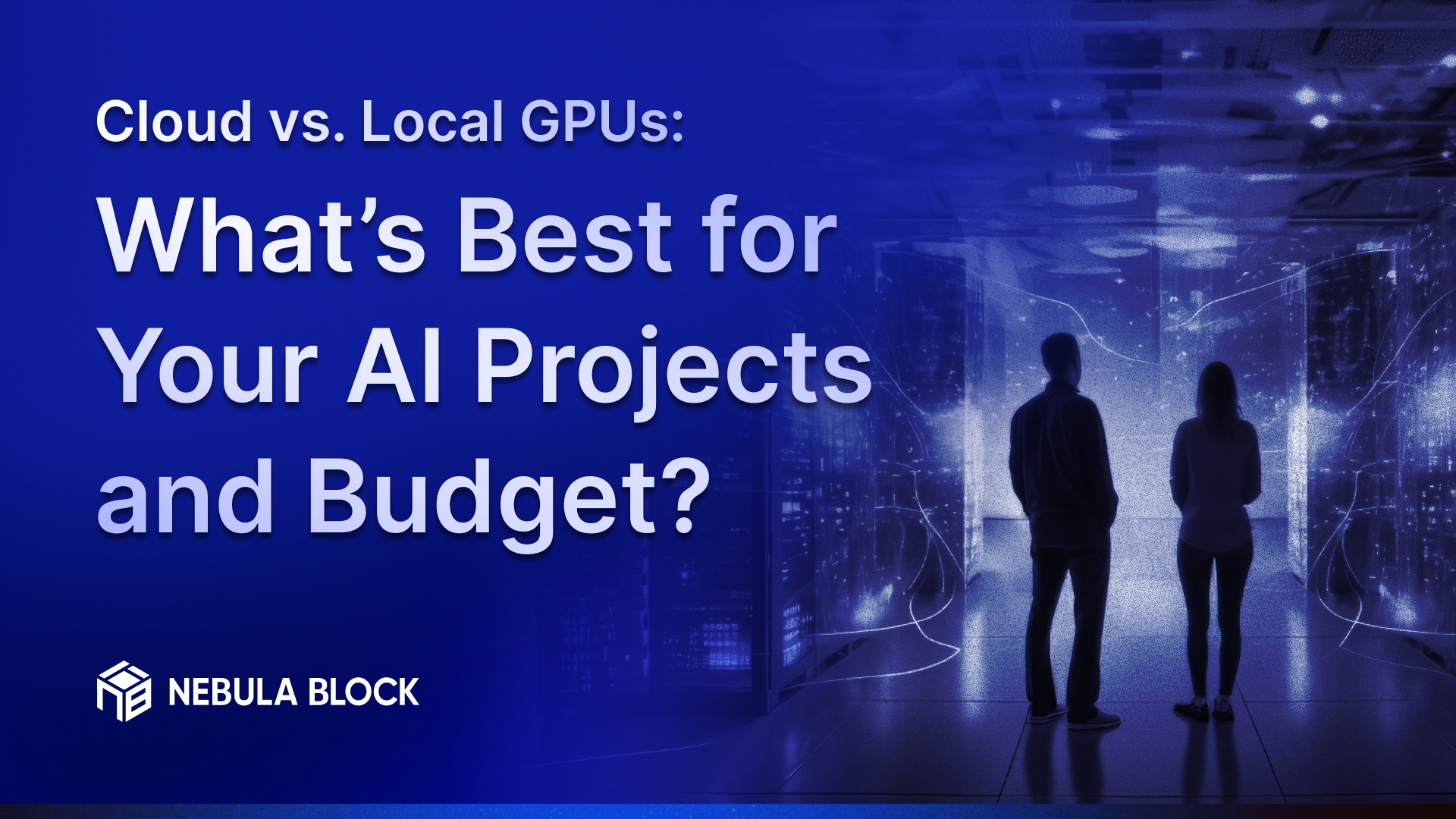Cloud vs. Local GPUs: What’s Best for Your AI Projects and Budget?

Choosing between cloud GPUs and local GPUs is a key decision for any AI project. Your ideal setup depends on your compute needs, budget constraints, and how flexible or scalable your workload must be.
But how do you know which setup truly fits your use case — whether you're building LLMs, training vision models, or running lightweight inference tasks? Let’s break down the pros and cons of each to help you decide.
Cloud GPUs: Pay-as-You-Go Power
Cloud GPUs are remotely hosted graphics processing units leased from cloud service providers. Here are some advantages:
✅ Advantages
- Low Upfront Cost: Great for users with tight budgets or those just starting out. You can begin training without spending thousands on hardware.
- Scalability: Instantly spin up multiple GPUs—like A100s, H100s, or L40S—without buying them.
- Pay-as-You-Go: Only pay for what you use, avoiding hardware underutilization.
- No Maintenance: No need to manage hardware failures, driver conflicts, or electricity bills.
- Wide GPU Selection: Switch easily between models (e.g., 4090 for fine-tuning, A100 for multi-GPU training).
- Faster Prototyping: Ideal for rapid experiments, workshops, or hackathons.
- Collaboration-Friendly: Teams in different regions can access the same resources.
- Reserved Instances: Long-running jobs can save costs by reserving compute.
🚫 Drawbacks
- Long-Term Cost: Renting GPUs over time may become more expensive than owning one.
- Internet Dependence: Requires stable internet, especially for large dataset transfers.
- Session Limits: Some platforms shut down idle instances or charge for storage time.
Local GPUs: Control & Consistency
On the other hand, local GPUs refer to dedicated GPU hardware that you purchase and manage on-site. The benefits include:
✅ Advantages
- One-Time Investment: Ideal if you're running models frequently. A powerful GPU like the RTX 4090 pays off over time with consistent usage.
- Direct Disk Access: Load datasets from local drives for faster iteration.
- Environment Control: Full authority over software stack and OS configuration.
- Offline Capability: Ideal for sensitive environments with restricted internet access.
🚫 Drawbacks
- Upfront Cost: A high-end GPU setup (GPU + CPU + RAM + PSU + cooling).
- Limited Scalability: You’re stuck with what you bought — scaling up means buying more machines.
- Maintenance Overhead: Troubleshooting drivers, failing components, and setup takes time.
- Single-User Limitation: Not ideal for teams or remote collaboration.
- Resale Loss: Hardware depreciates quickly and may become outdated within 2–3 years.
Nebula Block: Best of Both Worlds
Nebula Block is the first Canadian sovereign AI cloud, designed for performance, control, and compliance. It offers:
- Hourly GPU rental: both on-demand and reserved GPU instances, from NVIDIA B200, H200, H100 down to RTX 4090, 5090, Pro 6000 and more.
- Free serverless inference for testing and light workloads
- Multi-GPU support for large-scale training and RAG pipelines
- Model hub integration and persistent storage
- Compatible with Hugging Face, PyTorch, JAX, and other leading frameworks
- Infrastructure across Canada and globally: supports low-latency access for users worldwide
Whether you're fine-tuning a vision model, experimenting with a 12B-parameter LLM, or training a stable diffusion pipeline, Nebula Block helps you scale instantly—without long-term commitment.
How to Choose?
| Criteria | Go Cloud | Go Local GPU |
|---|---|---|
| Budget (Short-Term) | Low upfront cost | Expensive to buy |
| Budget (Long-Term) | Can be expensive over time | One-time purchase |
| Workload Size | Easy to scale large jobs | Limited by single machine |
| Usage Frequency | Ideal for occasional training | Ideal for heavy daily use |
| Technical Expertise | Minimal maintenance | You manage all issues |
| Experimentation | Rapid prototyping | Setup overhead |
| Team Collaboration | Cloud access for teams | Local machine only |
| Scalability | Instantly scale up/down based on needs | Fixed by hardware limits |
| Hardware Flexibility | Switch GPU types easily (4090, A100, etc.) | Locked to specific hardware |
| Performance (Latency) | May encounter network bottlenecks | Direct local access |
| Maintenance | Managed by provider (Nebula Block) | Manual updates, driver installs, etc. |
| Use Case Fit | Best for fine-tuning, RAG, diffusion, ad-hoc training | Best for persistent training pipelines |
| Startup Time | Ready in minutes | Setup/configuration may take hours/days |
So, Which One Should You Choose?
- If you’re a student, researcher, or startup, Nebula Block gives you instant access to high-performance GPUs with minimal overhead.
- If you’re running long-term, stable workloads and have strong technical skills, a local GPU setup may bring better ROI over time.
- For many teams, a hybrid approach works best: prototype and iterate locally, then scale to cloud for training or deployment.
Ready to Train Smarter?
Sign up and explore now.
🔍 Learn more: Visit our blog and documents for more insights or schedule a demo to optimize your search solutions.
📬 Get in touch: Join our Discord community for help or Contact Us.
Stay Connected
💻 Website: nebulablock.com
📖 Docs: docs.nebulablock.com
🐦 Twitter: @nebulablockdata
🐙 GitHub: Nebula-Block-Data
🎮 Discord: Join our Discord
✍️ Blog: Read our Blog
📚 Medium: Follow on Medium
🔗 LinkedIn: Connect on LinkedIn
▶️ YouTube: Subscribe on YouTube